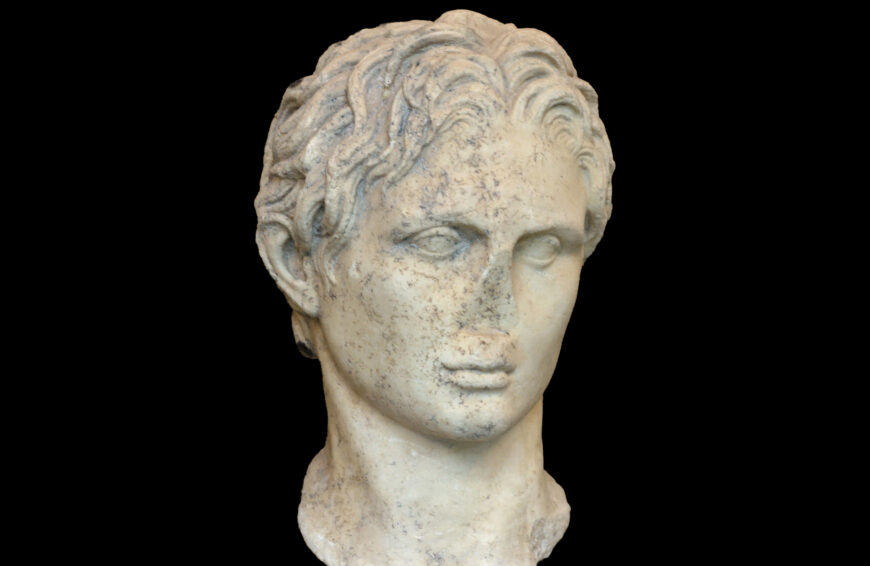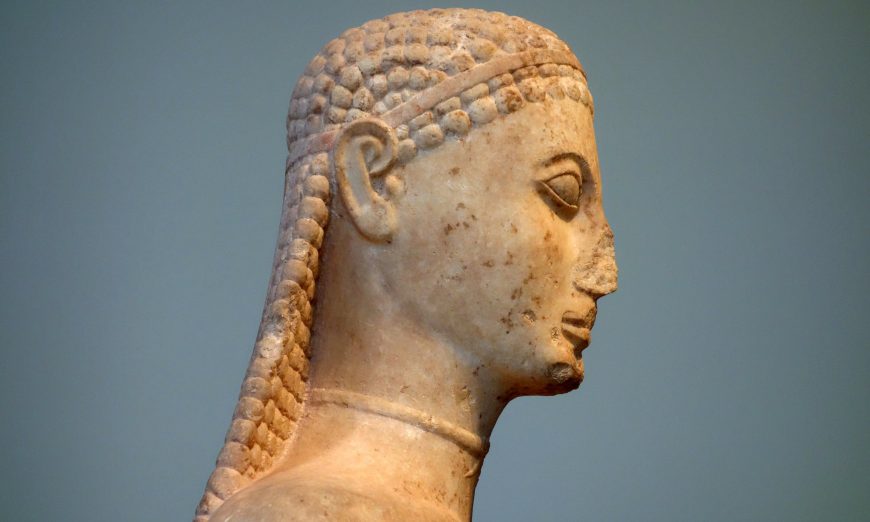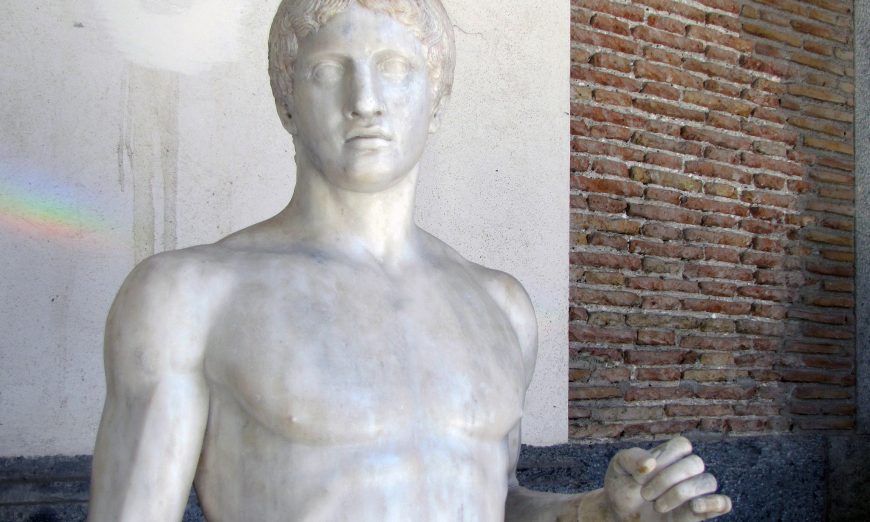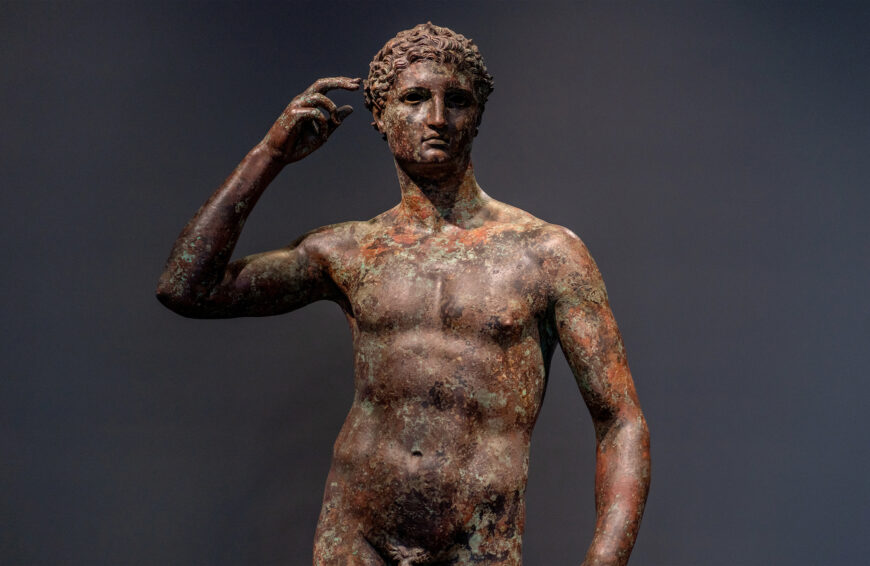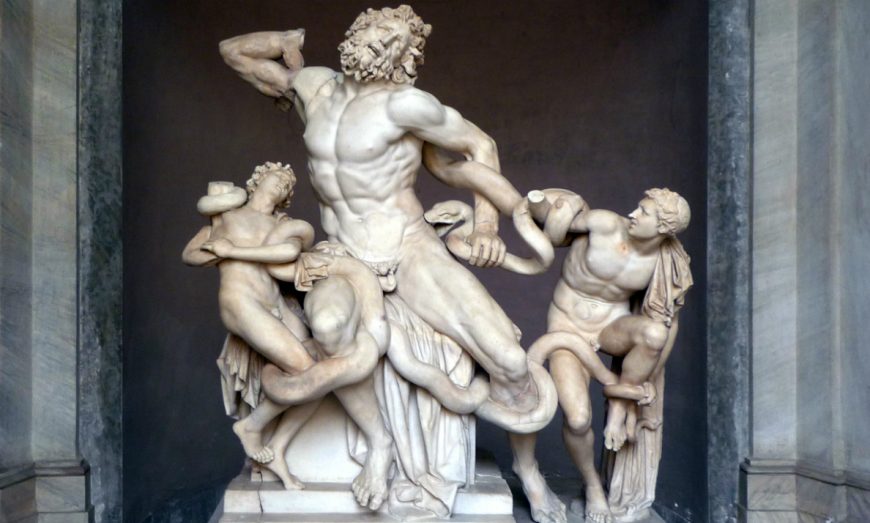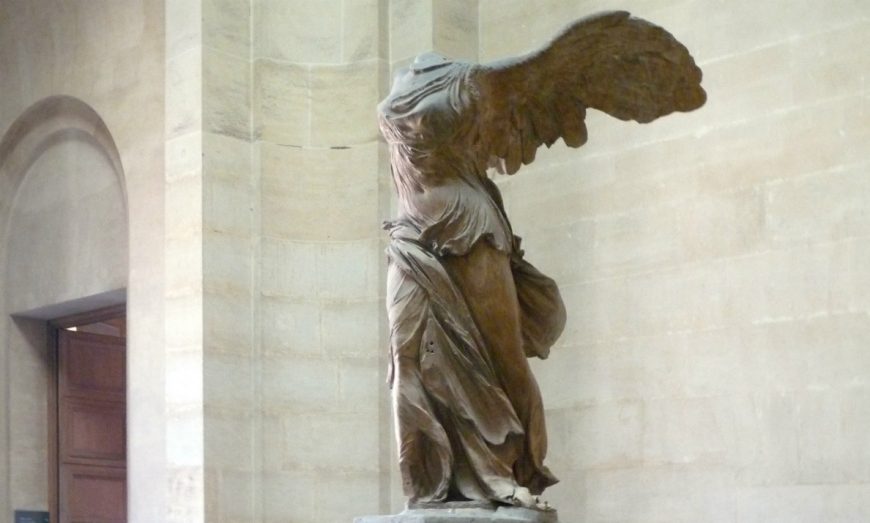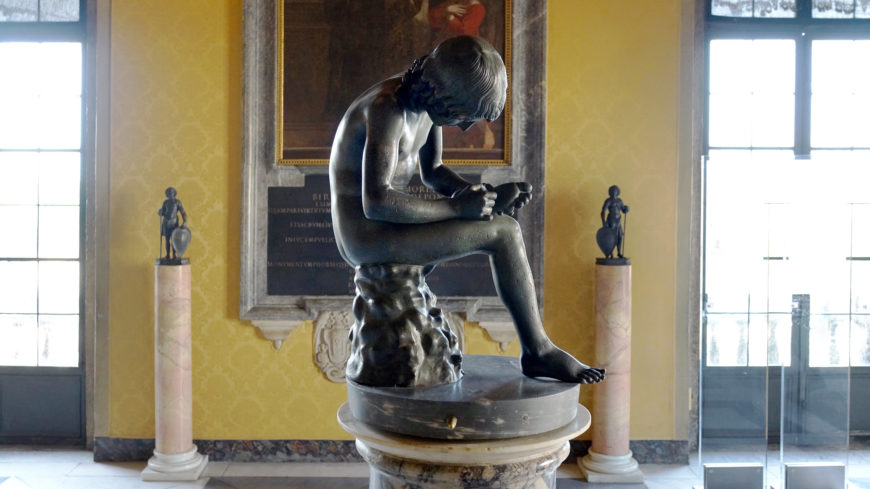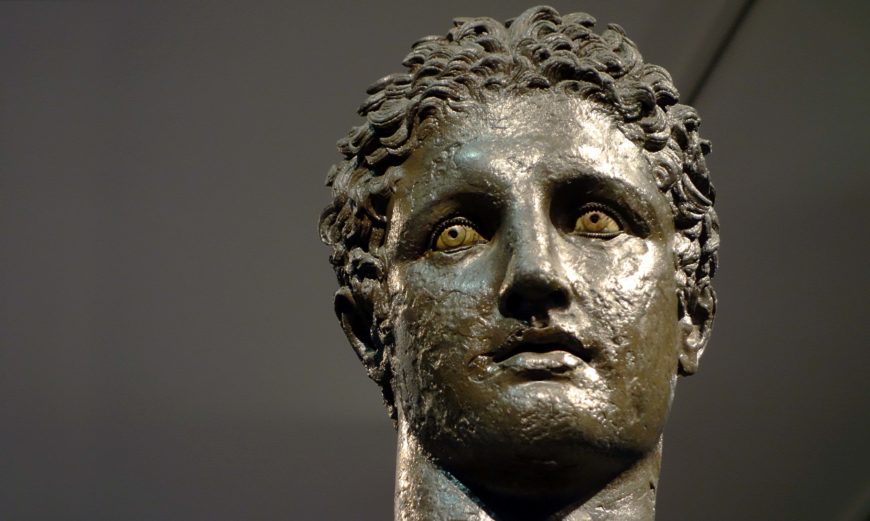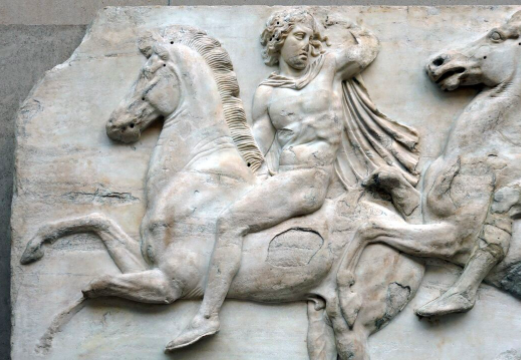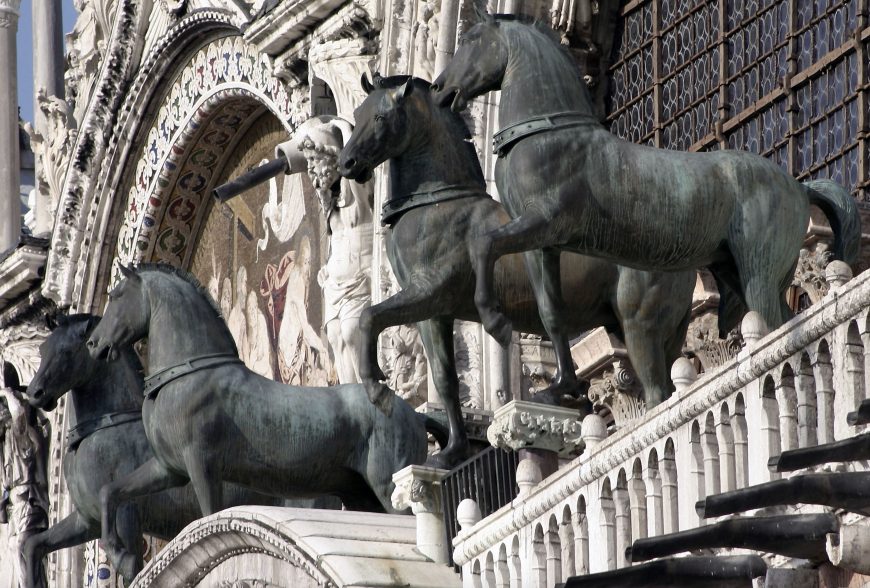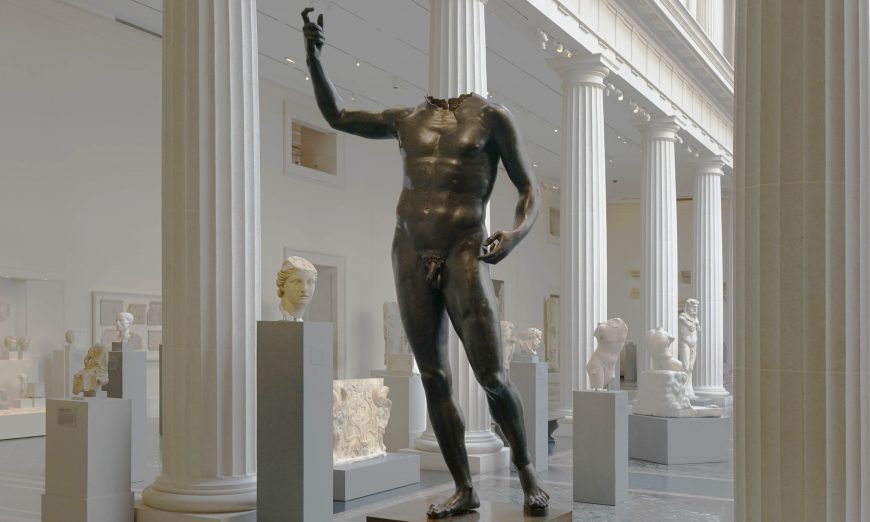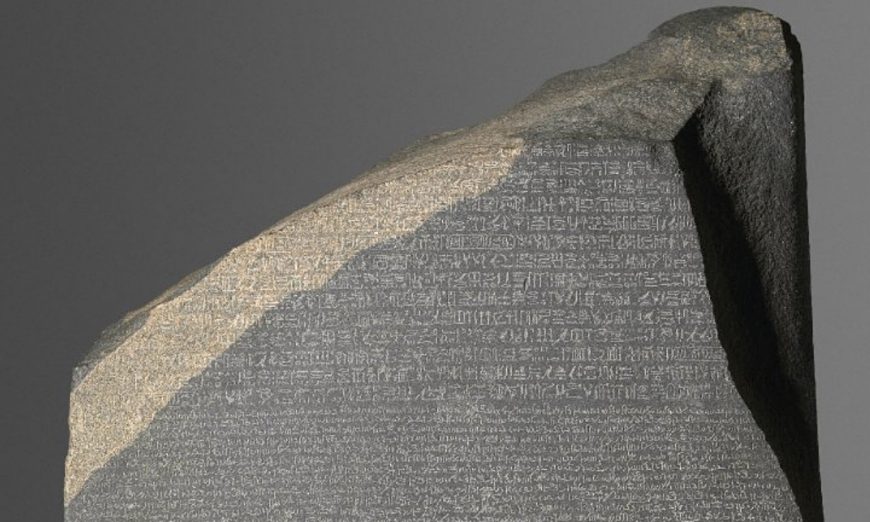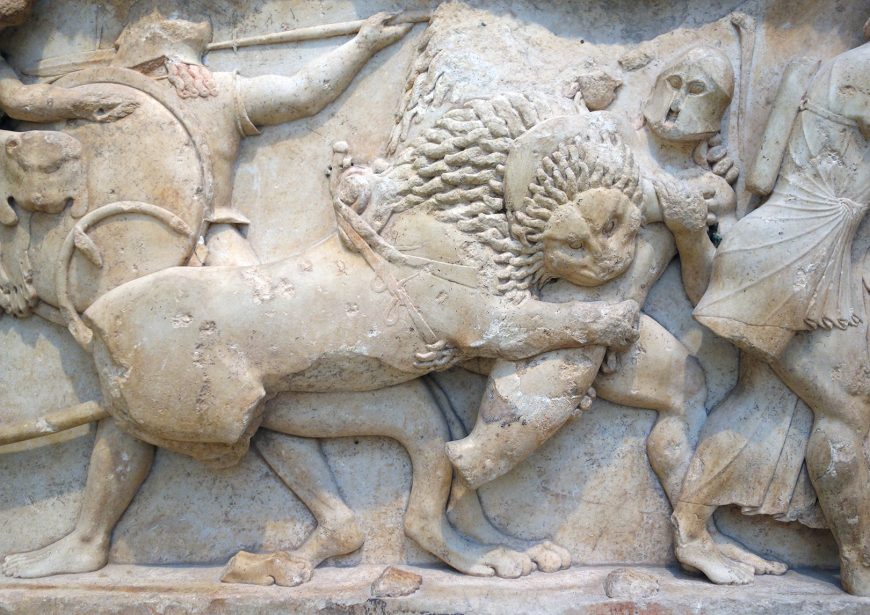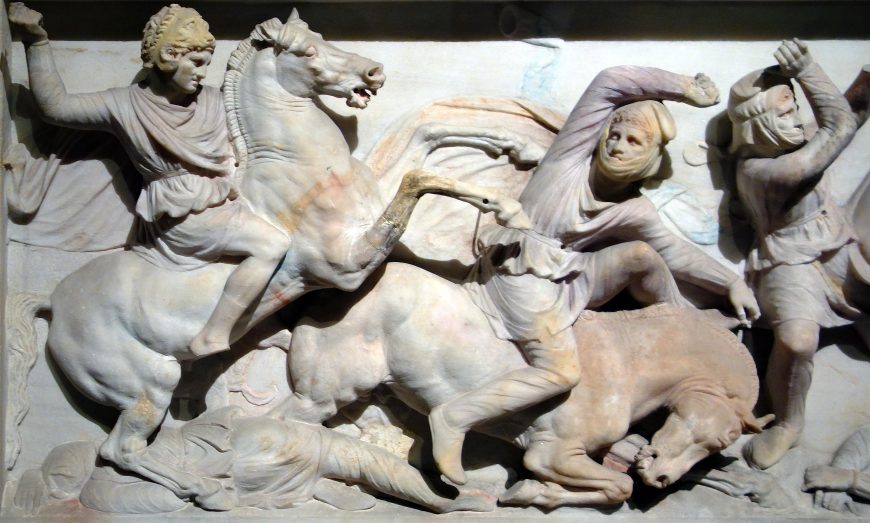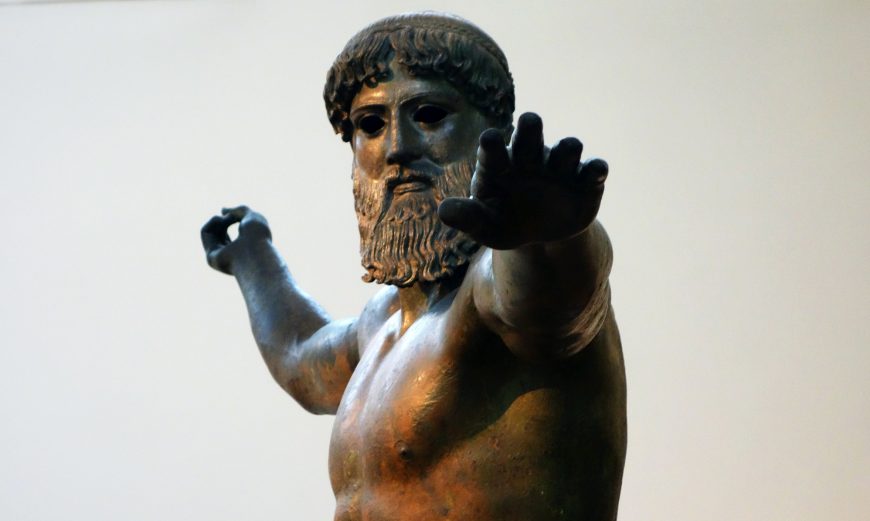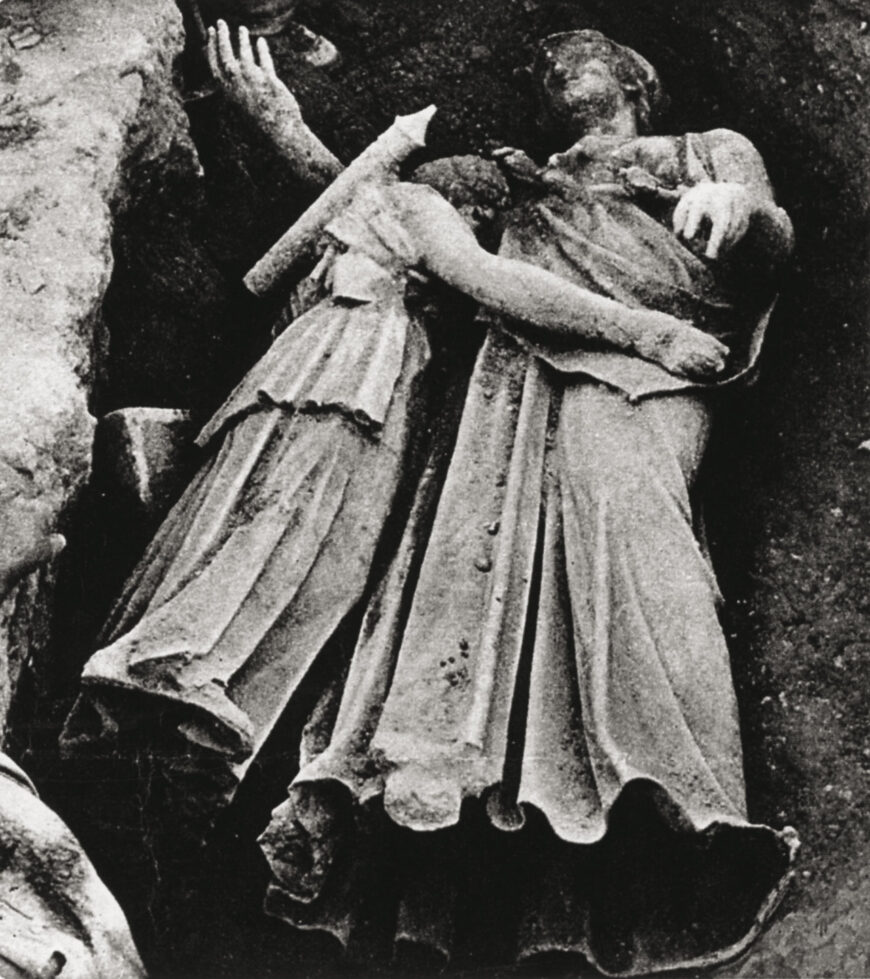
Bronze statues of Athena and Artemis as found in Piraeus in 1959 (Photo Archive of the Archaeological Society of Athens)
An unexpected discovery
One morning in 1959, workers digging a sewer line in Piraeus (the port city of Athens, Greece) were shocked to discover a group of ancient Greek sculptures beneath the soil. Archaeologists quickly took over the site and began rescue excavations to save the artifacts that were exposed by the construction. [1] They found five bronze statues of gods and goddesses, along with several other artifacts, all carefully arranged. The best preserved statue in the group, a bronze sculpture of the goddess Athena, was lying beside a smaller bronze statue of the goddess Artemis.
Using the evidence discovered during the excavations, scholars came up with a hypothesis about how these ancient statues came to be buried in Piraeus. Most archaeologists now believe that the sculptures were brought to Piraeus from elsewhere in Greece sometime in the 1st century B.C.E. They were being stored in a warehouse in Piraeus, waiting to be shipped out of Greece (likely to Rome, where Greek statues were much admired), when a huge fire destroyed much of the city. [2] The bronze statues that had been awaiting shipment were buried in the rubble and only discovered thousands of years later.
Because bronze is a valuable metal that is easy to melt down and reuse, ancient bronze statues rarely survive today. This makes the discovery of the statues at Piraeus even more important. The statue of Athena is the best preserved of them all. It is a rare example of an over life-size Greek bronze sculpture of a goddess. Today it is known as the Piraeus Athena because of its findspot. In the following paragraphs, we will consider how we know this statue depicts Athena, what the style of the sculpture suggests about when (and by whom) it was made, and what the sculpture’s original purpose might have been before it was moved to Piraeus.
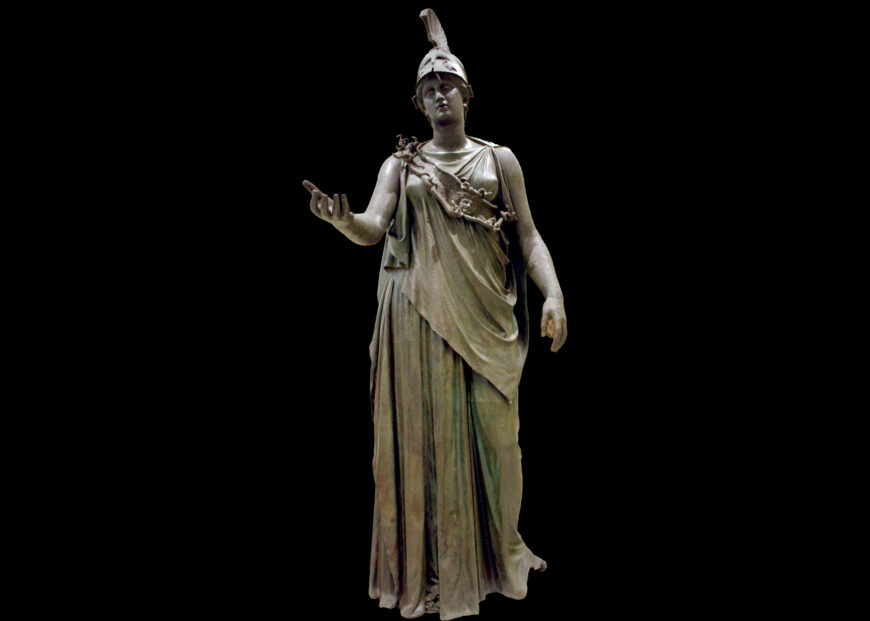
Piraeus Athena, c. 350 B.C.E., bronze, 2.35 m high (Archaeological Museum of Piraeus; photo: Giovanni dall’Orto)
Identifying Athena
We can tell which Greek goddess this statue represents because of what she is wearing. Over her long dress, across her chest, she sports a garment that looks almost like a sash. The sash has snakes emerging from its edges and a gorgon’s head near its center. This is a kind of protective garment called an aegis. Athena often wore an aegis to protect herself from harm. As the goddess of war, she was frequently shown with weapons and armor, as if she was prepared for battle. This sculpture also shows her wearing a helmet with a tall crest, pushed up on top of her head, further demonstrating her warlike nature. In antiquity, this Athena likely held a spear and shield with her left hand, which would have made her even more combative. [3] She also probably held something in her outstretched right hand, but scholars don’t agree on what that object was. [4] Although the items Athena held in her hands do not survive today, we can still tell who she is because of her aegis and helmet.
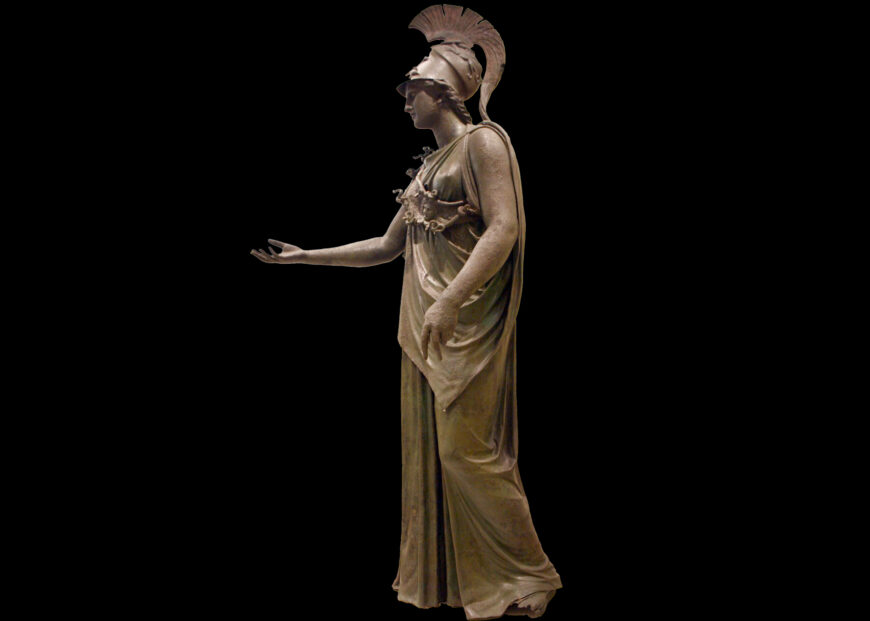
Piraeus Athena, c. 350 B.C.E., bronze, 2.35 m high (Archaeological Museum of Piraeus; photo: Giovanni dall’Orto)
Late Classical style
Having identified this statue as a representation of Athena, we can now consider its style. The Piraeus Athena wears a thick, heavy garment that hangs from her body in folds. Despite the heaviness of her garment, we can still see that Athena is standing with her left leg bent, free of weight, while her right leg carries her weight. Her right shoulder is lower than her left shoulder, and her right arm is extended while her left arm (which once rested on a shield) hangs down more casually. This posture is an exaggerated example of contrapposto, an asymmetrical pose that Greek sculptors invented in the High Classical period to show human figures more naturalistically. The Piraeus Athena almost pushes beyond contrapposto: her body seems to turn slightly from left to right, encouraging the viewer to walk around her, and her extended arm causes her to stoop slightly. [5] This kind of extreme contrapposto was especially popular in sculptures made during the Late Classical period, which extended from c. 400–323 B.C.E. In part because of this exaggerated posture, scholars believe the Piraeus Athena was likely made during the Late Classical period.
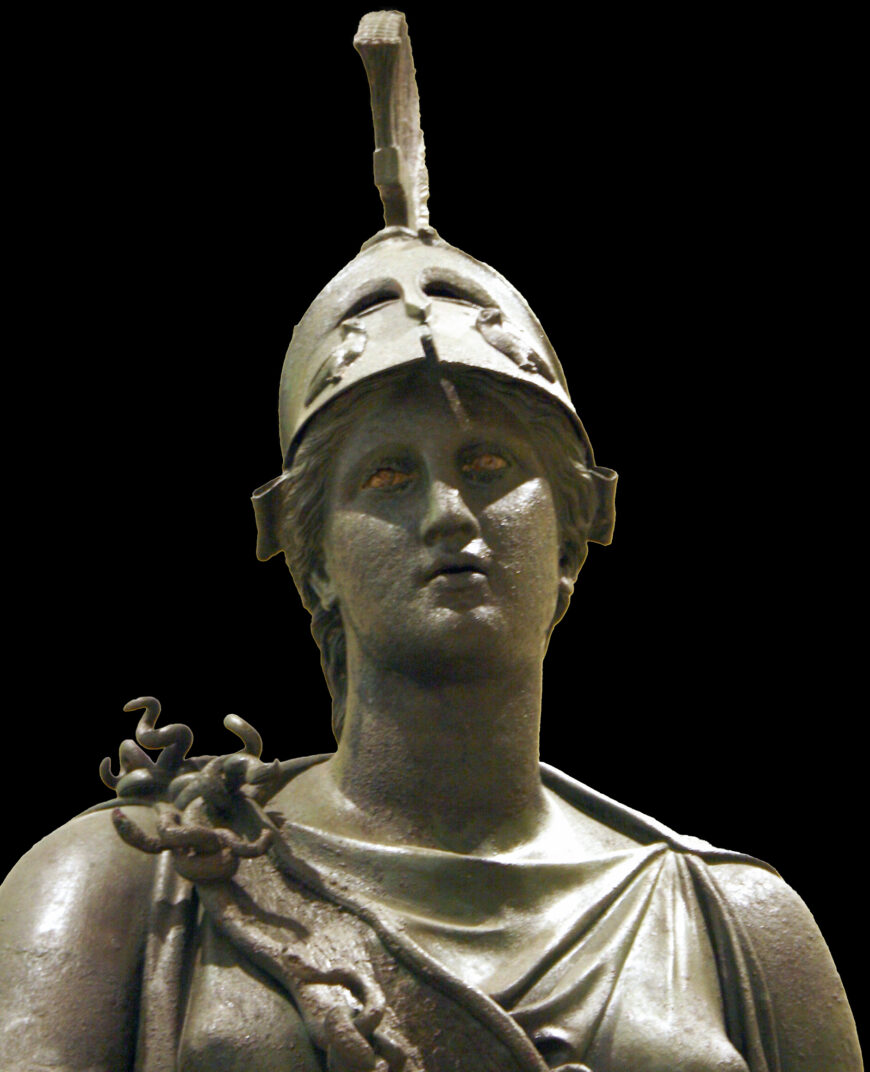
Head (detail), Piraeus Athena, c. 350 B.C.E., bronze, 2.35 m high (Archaeological Museum of Piraeus; photo: Giovanni dall’Orto)
There are other elements of Late Classical style in the Piraeus Athena. Her outstretched hand and bent posture make her seem almost approachable, as do her tilted head and peaceful expression. [6] Her gaze—made all the more lifelike because her eyes are inlaid with white stone—is calm. [7] Her lips are slightly parted. Although the statue is large and imposing, Athena is not especially intimidating. Her overall mood seems peaceful. Approachable, naturalistic representations of gods became popular during the Late Classical period. This trend is clearly evidenced in this commanding but serene statue. Without undermining Athena’s godly power, the artist who created this sculpture made her seem engaged and approachable.
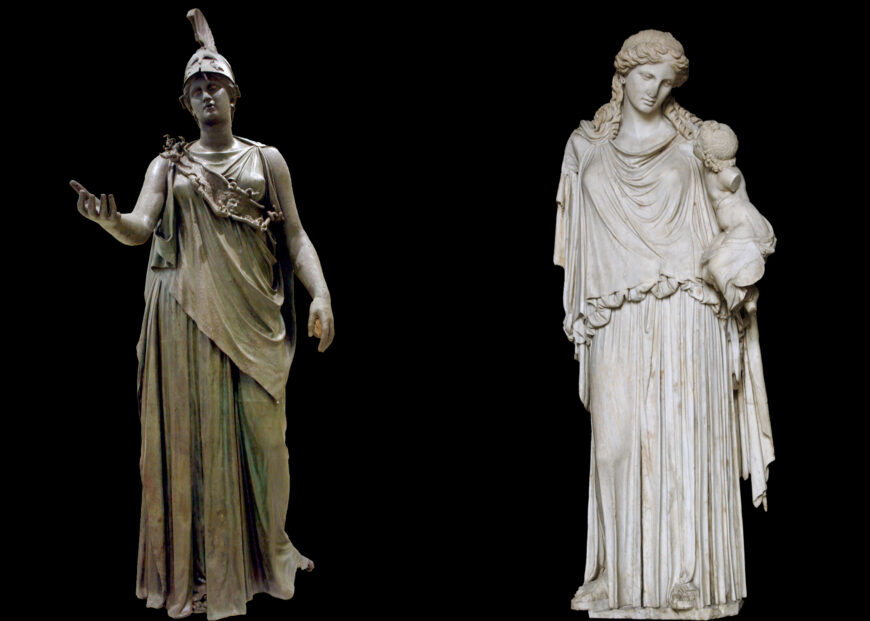
Left: Piraeus Athena, c. 350 B.C.E., bronze, 2.35 m high (Archaeological Museum of Piraeus; photo: Giovanni dall’Orto); right: Kephisodotos the Elder, Eirene and Ploutos, Roman marble copy of a Greek bronze original from c. 370–360 B.C.E., 2.1 m high (Glyptothek, Munich; photo: Bibi Saint-Pol)
The artist behind the statue
The Piraeus Athena has many stylistic traits that suggest it was made during the Late Classical period. Today, scholars often debate which artist made the statue. There are two primary candidates. The first is Kephisodotos the Elder, an Athenian sculptor who worked before c. 360 B.C.E. [8] In some ways, the Piraeus Athena is similar to Kephisodotos’s most famous work, a sculpture of the goddess Eirene (the embodiment of peace) and her infant son Ploutos (the embodiment of wealth). Both Eirene and Athena wear heavy garments with lots of long, linear folds. Both goddesses have peaceful expressions and seem quite serene overall. However, the Piraeus Athena stands in a much more exaggerated contrapposto than does Eirene, and her head is less dramatically inclined. [9] Moreover, Kephisodotos’s original statue of Eirene and Ploutos does not survive: only Roman copies in marble, rather than bronze, are available to us today. It is much more difficult to determine how similar Kephisodotos’s style is to that of the Piraeues Athena because we can only study it in copies.
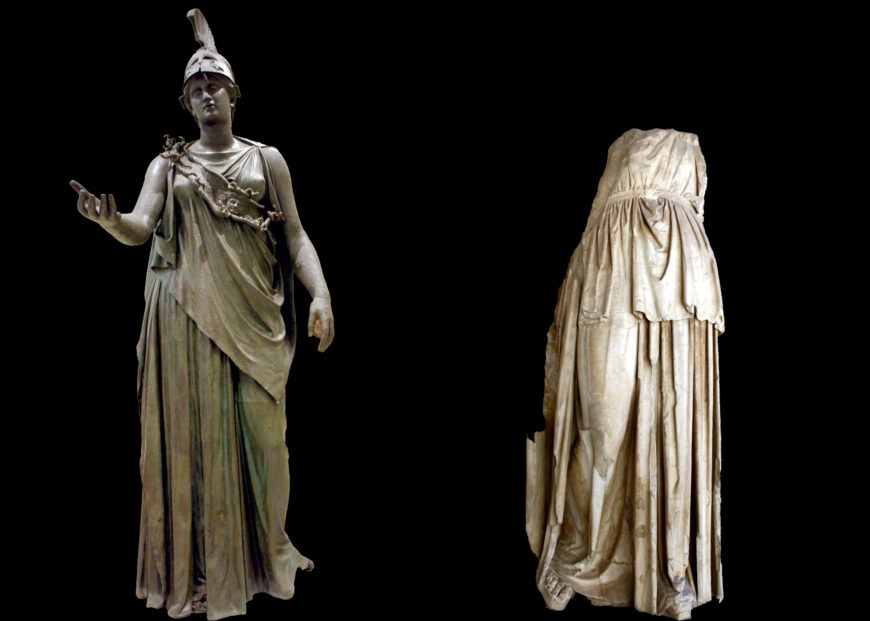
Left: Piraeus Athena, c. 350 B.C.E., bronze, 2.35 m high (Archaeological Museum of Piraeus; photo: Giovanni dall’Orto); right: Euphranor, Apollo Patroos, c. 340–330 B.C.E., marble, 2.54 m high (Museum of the Ancient Agora, Athens; photo: Giovanni dall’Orto)
The Piraeus Athena bears many stylistic similarities to another ancient statue. This partially preserved sculpture shows the god Apollo. It is a Greek original by the artist Euphranor. The bronze Athena and the marble Apollo stand in exaggerated contrapposto, visible even beneath their heavy garments. Their hips and shoulders shift dramatically, making them seem lively, and encouraging viewers to walk around them. Because of the similarities between these sculptures, some scholars have suggested that the Piraeus Athena was made by Euphranor. [10] Without an artist signature or a better understanding of Euphranor’s work, it is difficult to determine whether this is true with any real certainty.
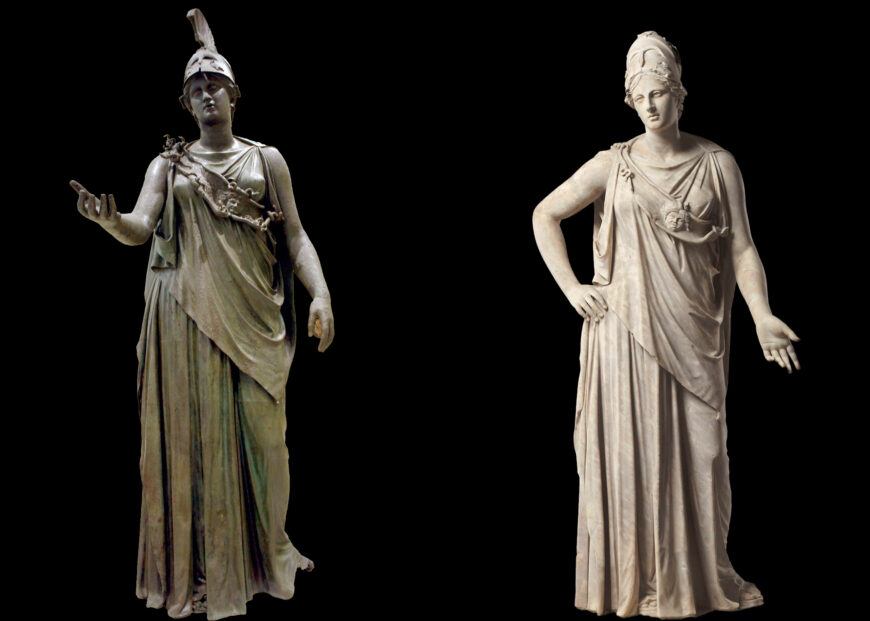
Left: Piraeus Athena, c. 350 B.C.E., bronze, 2.35 m high (Archaeological Museum of Piraeus; photo: Giovanni dall’Orto); right: Athena Mattei, later marble copy of a Greek bronze original from c. 350 B.C.E., 2.3 m high (Musée du Louvre, Paris)
Hypothesizing the function of the Piraeus Athena
With the information available to us today, it is impossible to say which artist made the Piraeus Athena. Despite this, we can confidently hypothesize that it was an important, celebrated statue even in ancient times. Its importance is suggested by the fact that a marble copy of the statue survives today: ancient sculptors clearly thought the Piraeus Athena was important enough to imitate. [11] The marble copy is almost the exact same size as the Piraeus Athena, and stands in a similar posture, though the marble statue’s right hand rests on her hip rather than being outstretched in front of her. The artist may have made this adjustment because marble is much heavier than bronze, and the arm was less likely to break off if it was attached to the body of the statue.
Although we don’t have much information about where the Piraeus Athena first stood, its large size and excellent quality suggest it may have originally been a cult statue. In ancient Greece, cult statues were representations of gods that received worship. The artist who made this statue was technically accomplished, and used the Late Classical style to create an approachable representation of the goddess Athena that was later copied in marble. This bronze statue only survives because a fire in the port city of Piraeus prevented it from being exported from Greece. The accident resulted in its preservation, ensuring that today we are able to study it closely and understand its significance as a rare Late Classical bronze sculpture.



